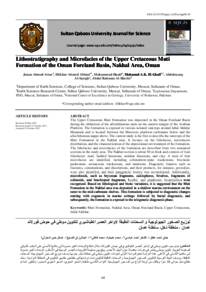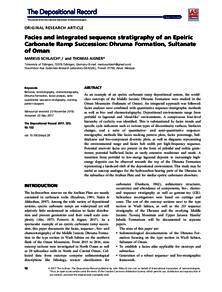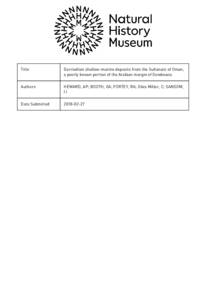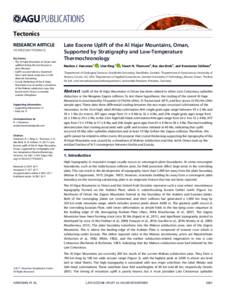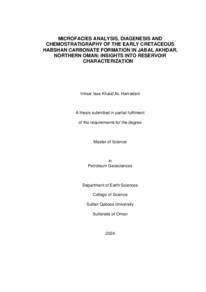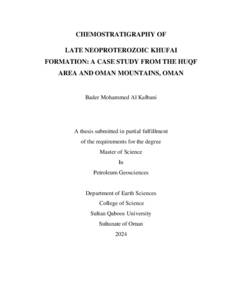Document
Lithostratigraphy and microfacies of the upper cretaceous muti formation of the Oman foreland basin, Nakhal area, Oman.
Identifier
DOI:10.53539/squjs.vol29iss1pp68-85
Source
Sultan Qaboos University Journal for Scientific. v. 28, no. 1, p. 68-85.
Contributors
Abbasi, Iftikhar Ahmed., Author
Hanif, Muhammad., Author
El-Ghali, Mohamed A. K., Author
Al-Sayigh, Abdulrazaq., Author
Al-Harthi, Abdul Rahman., Author
Other titles
توزيع الصخور الجيولوجية و السحنات الدقيقة لأواخر العصر الطباشيري لتكوين موطي في حوض فورلاند عمان، منطقة نخل، سلطنة عمان.
Country
Oman.
City
Muscat.
Publisher
College of Science, Sultan Qaboos University.
Gregorian
2024-04-24
Language
English
Subject
English abstract
The Upper Cretaceous Muti Formation was deposited in the Oman Foreland Basin during the obduction of the allochthonous units on the eastern margin of the Arabian Platform. The formation is exposed in various isolated outcrops around Jabal Akhdar Mountain and is located between the Mesozoic platform carbonates below and the allochthonous nappe above. The current study is the first to describe the outcrops of the Muti Formation in the Nakhal area. It focuses on the lithofacies, microfacies distribution, and the characterization of the depositional environment of the formation. The lithofacies and microfacies of the formation are described from two measured sections in the study area. The Nakhal section is about 50 m thick and consists of four lithofacies: marl, bedded limestone, nodular limestone, and clay. A total of four microfacies are identified, including echinoderm-spine wackestone, bioclastic packestone, arenaceous wackestone, and mudstone. Diagenetic features such as fractures, cementations, and dissolutions, and their products, for instance, porosities, were also identified, and their paragenetic history was reconstructed. Additionally, microfossils, such as bryozoan fragments, calcispheres, bivalves, fragments of echinoids, and brachiopod fragments, benthic and planktonic foraminifera were recognized. Based on lithological and biotic variations, it is suggested that the Muti Formation in the Nakhal area was deposited in a shallow marine environment on the outer to the mid-carbonate shelves. This formation is subjected to diagenetic changes starting with eogenesis in marine settings followed by burial diagenesis, and subsequently, the formation is exposed to the telogenetic diagenesis phase.
ISSN
2414-536X
Arabic abstract
ترسّب تكوين الموتي الطباشيري العلوي في حوض فورلاند العماني أثناء إعاقة الوحدات المتجانسة على الحافة الشرقية للمنصة العربية. يظهر التكوين في العديد من النتوءات المعزولة حول الجبل الأخضر ويقع بين منصة كربونات الدهر الوسيط أدناه والغطاء المتجانس أعلاه. الدراسة الحالية هي الأولى التي تصف نتوءات تكوين الموتي في منطقة نخل. ويركز على السحنات الحجرية، وتوزيع السحنات الدقيقة، وتوصيف البيئة الترسيبية للتكوين. تم وصف السحنات والسحنات الدقيقة للتكوين من قسمين مقاسين في منطقة الدراسة. يبلغ سمك قسم نخل حوالي 50 مترًا ويتكون من أربع سحنات حجرية: المرل، والحجر الجيري المبطن، والحجر الجيري العقدي، والطين. تم التعرف على إجمالي أربع سحنات دقيقة، بما في ذلك حجر الواكس شوكيات الجلد والعمود الفقري والحجر الرغامي الحيوي والحجر الرملي والحجر الطيني. تم أيضًا تحديد السمات التحويرية مثل الكسور، والترسيخ، والانحلالات، ومنتجاتها، على سبيل المثال، المسامية، وتم إعادة بناء تاريخها الجيني. بالإضافة إلى ذلك، تم التعرف على الأحافير الدقيقة، مثل شظايا البريوزوان، والكلسات الكروية، وذوات الصدفتين، وشظايا القنافذ، وشظايا ذراعيات الأرجل، والمنخربات القاعية والعوالق. استنادا إلى الاختلافات الصخرية والحيوية، يقترح أن تكوين الموتي في منطقة نخل قد ترسّب في بيئة بحرية ضحلة على الرفوف الخارجية إلى المتوسطة الكربونية. يتعرض هذا التكوين لتغيرات تحويرية بدءًا من عملية التولد في البيئات البحرية يليها تكوّن الدفن، وبعد ذلك، يتعرض التكوين إلى مرحلة التكوّن الانتهائي.
Category
Journal articles

